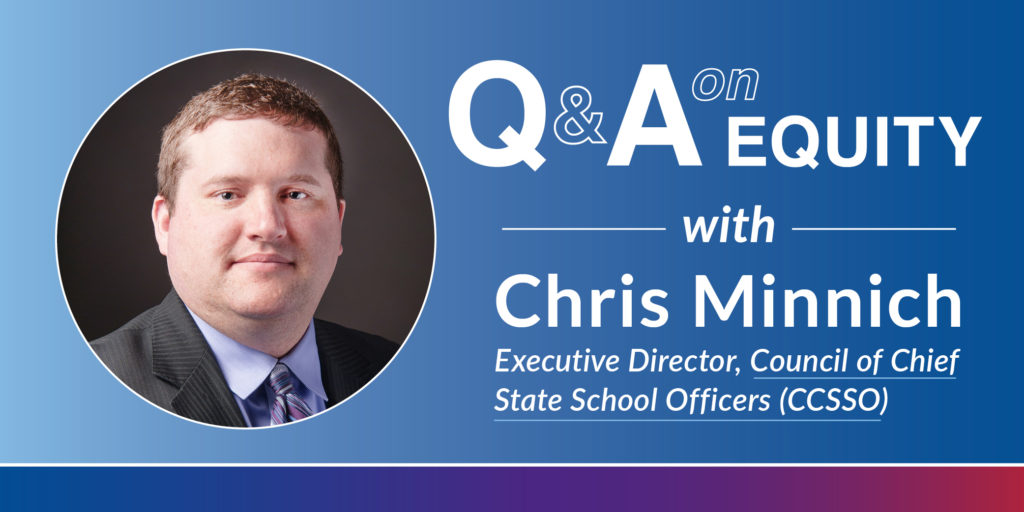

August 28, 2017

A: CCSSO worked closely with state chiefs and the Aspen Education & Society Program to develop our definition for equity as well as 10 commitments for how states can take action to address inequities in our education system. In that Leading for Equity report, we say, “Educational equity means that every student has access to the resources and educational rigor they need despite race, gender, ethnicity, language, disability, family background or family income. Every student deserves an education that prepares him or her for lifelong learning, success in the world of work and participation in representative government.”
State leadership on education equity is as important as ever right now, given the recent events in Charlottesville, VA and the national conversation that has followed. It is through education that we can work together toward positive action that can eradicate this type of hate and create safe, supportive learning environments and a better, more equitable world for all kids – especially those who have been historically marginalized and disadvantaged in our country.
For me, meaningful progress toward equity in education does not necessarily mean equal resources
for all. Every student is beginning at a different starting point. For example, we know some students – especially those from historically disadvantaged backgrounds – might be starting with less than their peers. Therefore, we have to meet students where they are at and provide some kids with more opportunities and resources so they can achieve the same level of success. That is equity.
A: If we are going to create an equitable education system, we have to change the way we address struggling schools. One of the major changes made through the Every Student Succeeds Act (ESSA)
is that states have much more authority over improving schools that have struggled for far too long. This new federal law is empowering states to work with stakeholders at the state and local level to reimagine how to provide supports to low-performing schools and the kids in those communities.
Most state chiefs are targeting the areas that need real improvement and focusing on closing the
gaps that still exist within their education systems. As we support states through their transition
and implementation of their ESSA plans, we will continue to push all states to identify strengths
and weaknesses and support schools and districts as they intervene to make changes for students.
I am excited about what I am seeing in states like Tennessee, Illinois and Nevada, among others. Tennessee has long been a leader in school improvement, but they are taking a renewed look and beginning to work more closely with district leaders to improve schools. Nevada is another example where the state is being innovative in identifying evidence-based practices and providing school districts with the opportunity to find the best strategy to meet their needs.
A: Educational equity is a priority for our state chiefs across the country. It is critical for state chiefs
to lead on equity because every state has gaps. We recognize the challenges and solutions will look different based on the state’s context, policy landscape and demographic makeup. This becomes
clearer every time I am in a state visiting schools. Last spring, for example, I was in Alaska. Even though every school we visited is part of one state and one public education system, the students in these communities face vastly different challenges. One day we were in Anchorage, where nearly 50 percent of students in the state attend school. The next day we flew to Noatak, a small village only accessible
by plane in Alaska’s arctic tundra, where students take many courses remotely through video-teleconferencing because the community is isolated. Alaska has to be thoughtful and creative
to meet the needs of all students.
I am pleased to see many states are addressing equity through their ESSA plans. Nevada, for example, has created a needs assessment to help every district identify the root causes of inequities so they can address them. Connecticut set a goal in its ESSA plan to increase the racial, ethnic and linguistic diversity of its educator workforce and outlined key strategies for getting there. In Louisiana, the state is creating a coaching program to provide job-embedded, continuous professional development to teachers across the state so they have the skills and knowledge necessary to support English learners. These are just a few of many examples across the plans submitted so far, and I know we will see more when all states submit in September.
A: Ensuring all kids have the resources and supports they need to be successful in life is the most difficult and most important work underway in our states today. State chiefs recognize they each have achievement gaps and inequities in their states, and are committed to asking the complicated questions and having the tough conversations to deliver the best for all of our students.
We know this work will not be easy. CCSSO realizes the lack of trust many Americans now have when it comes to the education system. Due to generations of inequity within education, some may have lost confidence that public officials are committed to ensuring that factors like race and socio-economic status do not determine students’ success. To regain trust and bridge this divide, state chiefs are working hard to make public their efforts to advance equity and empower stakeholders to address inequities. To support states in this, CCSSO joined the Aspen Education & Society Program earlier this year to put a stake in the ground around what equity means, why it is important, and how states can take action to address it. Together, we outlined 10 commitments, known as Leading for Equity: Opportunities for State Education Chiefs, state leaders can make to ensure educational equity for all kids in this country. From focusing on equity in strategic plans to analyzing funding formulas and disciplinary policies, the commitments are comprehensive and challenging yet necessary if we want all kids to succeed in college, careers and life.